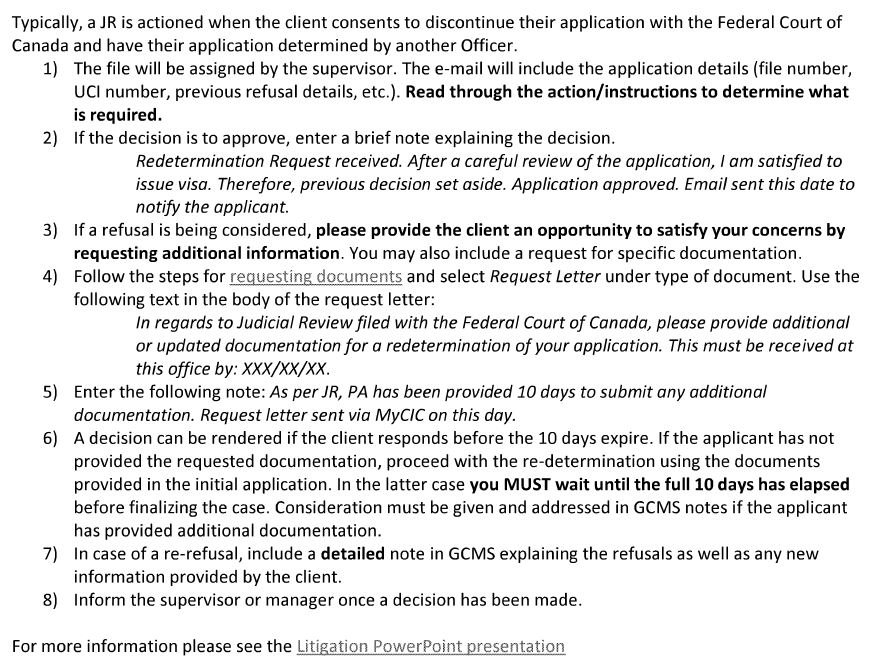By: Will Tao, Principal (Heron Law Offices)
Understandable in the circumstances of delay and unreasonable templated refusals, judicial reviews, particularly of temporary resident decisions such as study permits, have become a ‘hot commodity.’
The numbers of judicial reviews are through the roof this year, with Applicants experiencing delays in receiving leave decisions while counsel on the Department of Justice’s side are having difficulty triaging and in many cases even reaching their clients, the Visa Offices.
Counsel are filing these applicants hundreds at a time (with an increasing number of unauthorized practitioners participating) by copying and pasting the same arguments in every case. Some are even partnering with overseas agencies (often unauthorized reps) – who are largely using the same template applications, allowing for a cookie cutter approach. A perhaps unintended consequence of an open court system is the ability of any practitioner to access any JR file (including from some of the top counsel in Canada) and blindly duplicate. It is a practice at Heron was strongly stand against but accordingly to an informal survey I conducted, bulk judicial reviews are not unanimously despised by the practicing public, with many thinking its a good business model.
#CoachWill survey: hypothetical X legal practitioner filling 100s (if not more) AFLJRs, copying/pasting same arguments, charging thousands per filing. FC clogged full of these cases.
— Wei William (Will) Tao|陶维 (@TheWillTruth) September 8, 2022
Fishy or smart legal practice?
Or indication of a broken system + not lawyer fault.#cdnimm
Indeed one practitioner, quite aptly pointed out that counsel who do work permits for corporations file them by the hundreds too, so what makes filing JRs in the same way any different. It is a fair point and arguably we’re fighting more for the margins than someone doing bulk LMIAs.
But at the end of day these are also Canadian taxpayer dollars paying lawyers to litigate cases including some that frankly should not have either been filed in the first place (where study permits have become the only option for kick-starting immigration pathways, due to a lack of other work permit or PR-based options) or others that should not have been refused (where reasons are so poorly justified that litigation settlement is almost inevitable). There are also many cases that have limited proximity to Canada, as one DOJ lawyer I recently spoke to pointed out, and given the access to justice and courts concerns more broadly in Canada, one wonders if this is a useful use of resources to fund JRs for mature students attending no name community colleges. Nonetheless, there seems to have been some calculated risk made by IRCC that the litigation risk was worth the efficiency gains but this will have to be reconsidered on an ongoing basis.
The Merry-Go-Around
Because of the overmarketing of judicial reviews, there also seems to be an overpromising of what the process looks like. There’s also significant and growing confusion on whether or how judicial reviews and parallel applications (reconsiderations + new applications) go together. The later, I will save for a later blog but for now I do want to shed some light on what Justice Sadrehashemi in Mundangepfupfu v. Canada (Citizenship and Immigration), 2022 FC 1220 (CanLII), <https://canlii.ca/t/jrlf8> highlighted as the merry-go-round of endless judicial reviews.
She writes:
[38] The Supreme Court of Canada noted that
“it will most often be appropriate to remit the matter to the decision maker to have it reconsider the decision, this time with the benefit of the court’s reasons”(Vavilov at para 141). However, reviewing courts cannot be blind to the impacts on access to justice of endorsing“an endless merry-go-round of judicial reviews and subsequent reconsiderations”(Vavilov at para 142).[39] I am cognizant of the time and expense required to engage in the judicial review and reconsideration process. Going through multiple rounds of successful judicial review only to receive the same result with very similar reasons raises serious access to justice concerns and the potential for litigants to lose confidence in the justice system.
Mundangepfupfu at paras 38-39.
Having now filed several cases on their second round (first – consent, followed by re-refusal or inordinate delay), I wanted to shed some light on why I am increasingly skeptical that judicial review will ultimately achieve many end goals clients have of getting their application approved.
How Things Used to Be Following Consent or a Successful JR
There was a time where judicial review consent was pretty much automatic to approval. Issues would be resolved and within days and at most weeks, clients would be approved after a JR settled. Very rarely did they send out requests for further information beyond the occasional targeted ask for a missing document. Counsel at DOJ were able to personally engage often to ensure consents occurred quicker and to have dialogue over the case and share their client’s positions.
Those days unfortunately have long passed.
How the Merry Go-Round Works These Days
The merry-go-ground begins at the point of refusal. This can be done by template refusal decisions that either highlight multiple points of refusal or highlight the first point, but appear to exclude another point that could have been used for refusal.
What this does is at judicial review, where consent might have been made because of a reviewable error on one point, it still preserves the ability of a new Visa Officer to refuse on another ground (even the same ground) or add a subsequent ground. That is why as a practitioner, I am always cognisant of what is (but also what is not) in standard refusal letters and GCMS.
The next point that occurs is either in discontinuance. Note, strategically, there is not much of a benefit to bringing cases such as study permits up to an actual hearing for the Department of Justice, unless they are themselves trying to strategically litigate something (finances, travel history, use of Chinook, etc.) or otherwise there is a clear message litigation needs to send – e.g in protecting Officer discretion in H&C refusals. While you achieving a consent is considered a win, more and more counsel have to think about accepting a consent as triggering the merry-go around that ultimately may not get your client their result.
In these consents, you will typically now find language around COVID-19 related delays. It is interesting to see when they will remove this language, given where we are in what appears to be a shifting away from pandemic policies, but on their end (and with your acceptance) it gives the Visa Office leeway to take their time re-opening files. Again, where in the past cases would be followed up on quite quickly, it is now not uncommon to see the Visa Office take months to follow-up on a re-opened JR.
Their own guidelines (as highlighted from one Visa Office’s SOP) show that there is a process by which they deal with re-openings and that there is a set out strategy for re-refusing:

In our experience, we have had a mix of cases where they approved without sending a request, but a majority where a request was sent. However, almost none of them have requested specific documentation – frustrating the process for applicants.
The request usually looks like this (I’ve shared two redacted screenshots):


As you can see, there is very little guidance as to what is needed to be updated. However, from a student perspective – they may have had to get a new Letter of Acceptance (because their initial one expired), their financial situation, or work history may have changed. This creates a real gap/void in which an Applicant has to answer to. It opens up to possible refusal again on insufficiency for failure to update a document (but without knowledge of what needed to be updated).
Providing the Response, Delays (Mandamus), and Re-Refusals
After the response is provided, as I mentioned – several cases are approved shortly thereafter (passport request), but many sit, ostensibly awaiting further review. Webform requests are not answered. The Applicant really has no clue what is going on with their file until a subsequent decision is rendered. It is in these situations were I have experienced delays up to a year and where we have to contemplate mandamus. However it is at this stage, your client who has been waiting for a year starts to have other thoughts about whether Canada is correct. They have lost a year of their lives, likely paid for now several Federal Court processes, and have no interest in another round of litigation. For those that are refused again, we have found a mix of either mere lines/factual explanations added to refusal letters OR in some cases the exact same or added reasons. It is clear that these decisions have received further legal support and in some cases the adding of arguments made by counsel during the litigation.
In somewhat frustrating fashion, IRCC is also constantly shifting the goal posts with the language of refusal letters and as well add considerations that either adjust to reflect changing case law (e.g. recently, the payment of full tuition versus first year tuition only – see Prof Gideon Christian’s excellent article on this situation).
But What Are the Alternatives?
This is a fair question. Reconsideration requests are not being readily answered to, and of course provide the same opportunity to ‘bolster’ a decision – this time by the same decision-maker. Some folks have experienced success in applying for a new application at the same time litigation is ongoing, which appears to be a way to add leverage but it seems procedurally to be problematic as well. I have been careful as counsel not to engage with the tribunal on the matter (i.e. submit reconsiderations after filing JRs), but this new application route raises questions on whether the same principles of dealing directly with counsel apply.
At the end of the day, there is likely no alternative but to judicial review but clients should know that not all cases will be approved simply because a decision was made unreasonably or not procedurally fairly. There are enough tools in the Department of Justice and the Visa Office’s tool box to go back to the drawing board and refuse you again, unfortunately at the expense of your legal fees paid.
On a side note, we’re asking for costs in a case where they appeared to simply have re-refused without even entering new GCMS notes (based on a previous refusal). We’ll update you on how that goes!



